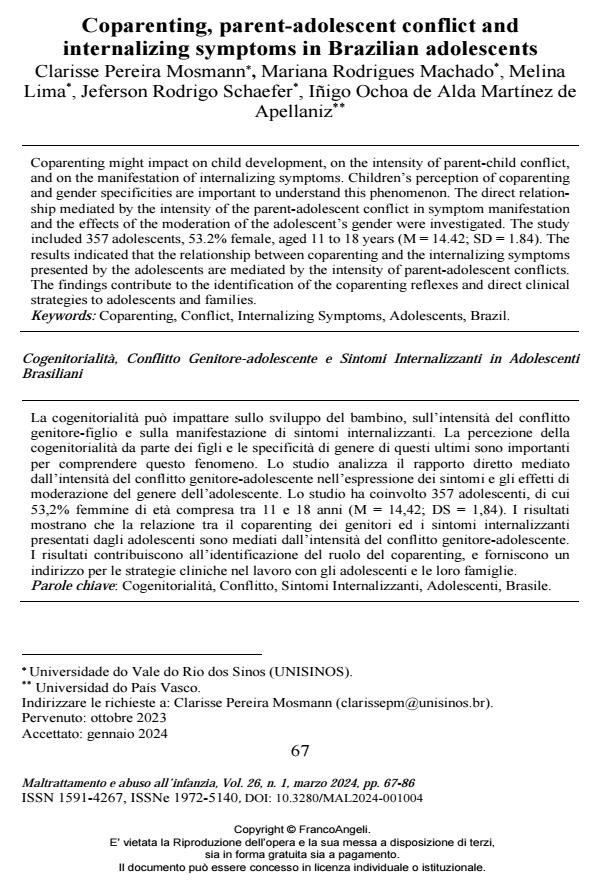Coparenting, parent-adolescent conflict and internalizing symptoms in Brazilian adolescents
Titolo Rivista MALTRATTAMENTO E ABUSO ALL’INFANZIA
Autori/Curatori Clarisse Pereira Mosmann, Mariana Rodrigues Machado, Melina Lima, Jeferson Rodrigo Schaefer, Iñigo Ochoa de Alda Martínez de Apellaniz
Anno di pubblicazione 2024 Fascicolo 2024/1
Lingua Inglese Numero pagine 20 P. 67-86 Dimensione file 244 KB
DOI 10.3280/MAL2024-001004
Il DOI è il codice a barre della proprietà intellettuale: per saperne di più
clicca qui
Qui sotto puoi vedere in anteprima la prima pagina di questo articolo.
Se questo articolo ti interessa, lo puoi acquistare (e scaricare in formato pdf) seguendo le facili indicazioni per acquistare il download credit. Acquista Download Credits per scaricare questo Articolo in formato PDF

FrancoAngeli è membro della Publishers International Linking Association, Inc (PILA)associazione indipendente e non profit per facilitare (attraverso i servizi tecnologici implementati da CrossRef.org) l’accesso degli studiosi ai contenuti digitali nelle pubblicazioni professionali e scientifiche
Coparenting might impact on child development, on the intensity of parent-child con-flict, and on the manifestation of internalizing symptoms. Children’s perception of coparenting and gender specificities are important to understand this phenomenon. The direct relationship mediated by the intensity of the parent-adolescent conflict in symptom manifestation and the effects of the moderation of the adolescent’s gender were investigated. The study included 357 adolescents, 53.2% female, aged 11 to 18 years (M = 14.42; SD = 1.84). The results indicated that the relationship between coparenting and the internalizing symptoms presented by the adolescents are mediated by the intensity of parent-adolescent conflicts. The findings contribute to the identifi-cation of the coparenting reflexes and direct clinical strategies to adolescents and fam-ilies.
La cogenitorialità può impattare sullo sviluppo del bambino, sull’intensità del conflitto genitore-figlio e sulla manifestazione di sintomi internalizzanti. La percezione della cogenitorialità da parte dei figli e le specificità di genere di questi ultimi sono importanti per comprendere questo fenomeno. Lo studio analizza il rapporto diretto mediato dall’intensità del conflitto genitore-adolescente nell’espressione dei sintomi e gli effetti di moderazione del genere dell’adolescente. Lo studio ha coinvolto 357 adolescenti, di cui 53,2% femmine di età compresa tra 11 e 18 anni (M = 14,42; DS = 1,84). I risultati mostrano che la relazione tra il coparenting dei genitori ed i sintomi internalizzanti presentati dagli adolescenti sono mediati dall’intensità del conflitto genitore-adolescente. I risultati contribuiscono all’identificazione del ruolo del coparenting, e forniscono un indirizzo per le strategie cliniche nel lavoro con gli adolescenti e le loro famiglie.
Parole chiave:Cogenitorialità, Conflitto, Sintomi Internalizzanti, Adolescenti, Brasile.
Clarisse Pereira Mosmann, Mariana Rodrigues Machado, Melina Lima, Jeferson Rodrigo Schaefer, Iñigo Ochoa de Alda Martínez de Apellaniz , Coparenting, parent-adolescent conflict and internalizing symptoms in Brazilian adolescents in "MALTRATTAMENTO E ABUSO ALL’INFANZIA" 1/2024, pp 67-86, DOI: 10.3280/MAL2024-001004